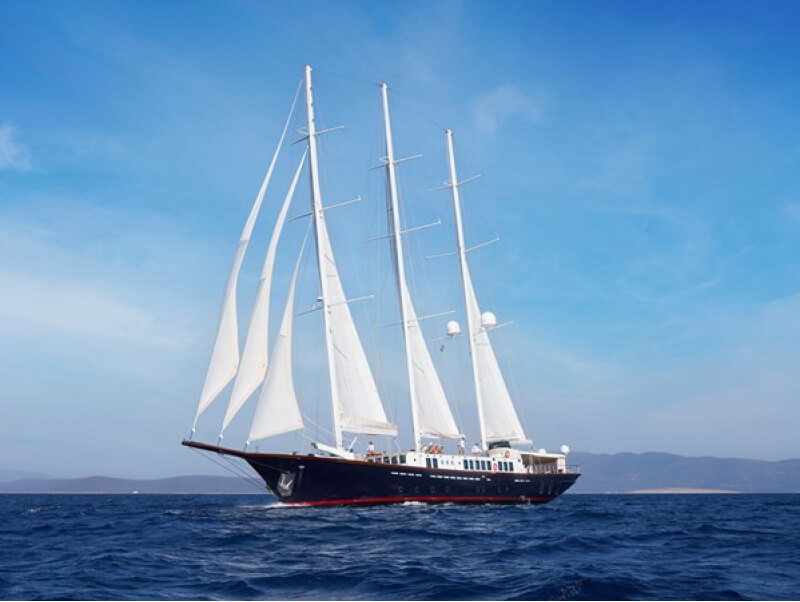When it comes to sailboats, there are various types that cater to different sailing needs and preferences. Whether you’re a seasoned sailor or just starting out, understanding the different types of sailboats can help you make an informed decision when choosing the right one for your adventures on the water.
By familiarizing yourself with different types of sailboats, you can better determine which one aligns with your sailing goals and preferences. Whether you seek speed, comfort, or versatility, there’s sure to be a sailboat out there that suits your needs perfectly. So get ready to hoist those sails and embark on unforgettable nautical adventures!
Understanding the Basics Types of Sailboats
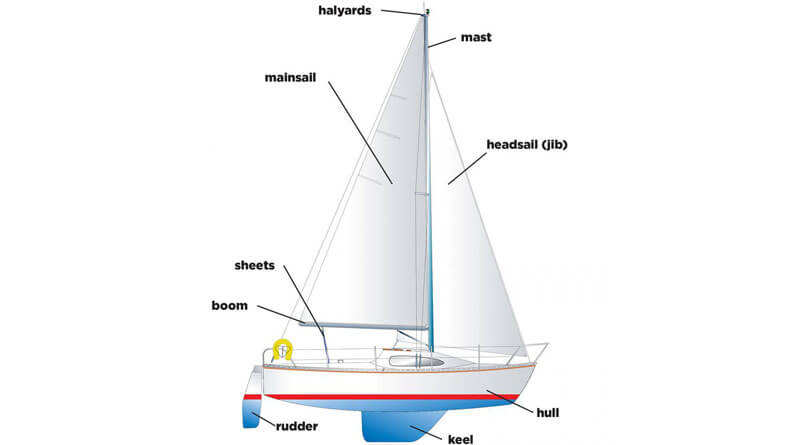
Sailboats, also known as sailing vessels or yachts, are fascinating watercraft that rely on wind power to navigate through the water. Whether you’re a seasoned sailor or a curious landlubber looking to explore the world of sailing, understanding the basics of sailboats is essential. In this section, we’ll break down some key aspects that will help you grasp the fundamentals.
Anatomy of a Sailboat
To understand how sailboats work, it’s important to familiarize yourself with their main components:
- Hull: The hull is the body of the boat and provides buoyancy and stability.
- Mast: The mast is a tall vertical structure that supports the sails and allows them to catch wind.
- Sails: Sails are large fabric surfaces attached to masts and booms. They capture wind energy and propel the boat forward.
- Rudder: The rudder is a movable appendage at the stern (rear) of the boat that controls its direction by altering water flow.
- Keel: The keel is a heavy fin-like structure located beneath the boat’s hull to prevent sideways drifting.
Types of Sailboats
Sailboats come in various types, each designed for specific purposes and conditions:
- Cruising boats are built for leisurely voyages and offer comfort and amenities for extended stays onboard.
- Racing boats are designed for speed and agility, with streamlined shapes and lightweight materials.
- Catamarans have two parallel hulls connected by a deck or trampoline, providing stability, spaciousness, and speed.
- Trimarans feature three hulls arranged in parallel fashion for enhanced stability while maintaining good performance.
Points of Sail
When sailing, understanding different points of sail helps determine how best to position your sails relative to the wind. Here are the main points of sail:
- Close-hauled: Sailing as closely into the wind as possible.
- Reaching: Sailing with the wind coming from the side.
- Running: Sailing with the wind coming from behind.
Sailboat Rigging
Sailboat rigging refers to the system of ropes, wires, and hardware that control and adjust sails. Some common rigging terms include:
- Mainsail: The primary sail attached to the mast.
- Jib: A smaller foresail positioned in front of the mast.
- Boom: A horizontal spar at the bottom edge of a mainsail used for control.
- Halyard: A line used to raise or lower a sail.
Understanding these basic concepts will set you on your way to becoming more confident and knowledgeable about sailboats. Whether you’re dreaming of leisurely cruising or competitive racing, sailing offers endless opportunities for exploration and adventure on the open water. So hoist those sails, catch that breeze, and let your nautical journey begin!
Read Also: Types of Boat Captain Licenses: A Comprehensive Guide
Categorizing Types of Sailboats by Hull Type
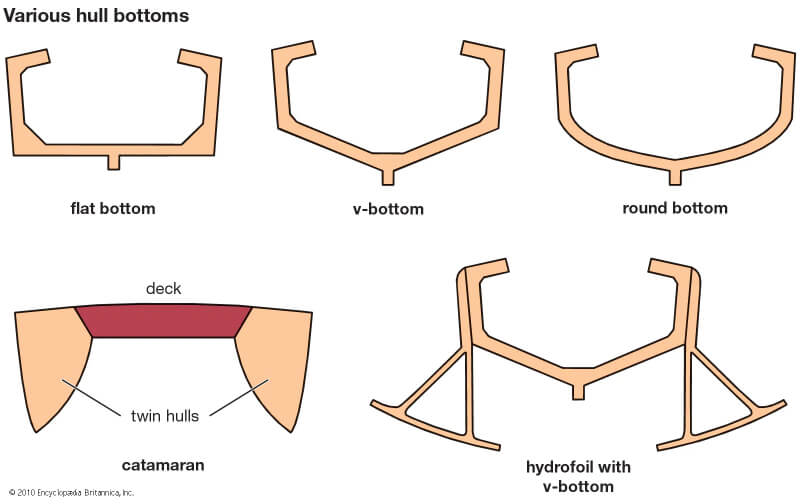
When it comes to sailboats, one way to categorize them is by their hull type. The hull is the main body of the boat that sits in the water and provides buoyancy and stability. Different hull types offer varying levels of performance, handling capabilities, and suitability for different sailing conditions.
Here are some common types of sailboat hulls:
Monohull
This is the most traditional and widely used type of sailboat hull. It features a single hull that extends from bow to stern. Monohulls can be further classified into different subtypes based on their design, such as full keel, fin keel, or modified keel.
Catamaran
A catamaran has two parallel hulls connected by a deck structure. This design offers increased stability and speed compared to monohulls. Catamarans are popular for cruising due to their spaciousness and comfortable living areas.
Trimaran
A trimaran has three parallel hulls connected by crossbeams. Trimarans provide excellent speed and stability even in rough seas. They are often used for racing or long-distance cruising.
Bilge Keel
Instead of having just one keel like a traditional monohull, bilge keel sailboats have two smaller keels on either side of the boat’s centerline. This design allows them to sit upright when grounded or moored in shallow waters.
Dinghy
Dinghies are small, lightweight boats typically used for recreation or racing purposes. They have a flat bottom with no fixed keel or ballast system, allowing them to navigate in shallow waters and be easily transported on trailers.
Cutter
A cutter is a type of monohull sailboat with two headsails – a jib and a staysail – set forward of the mast. This configuration provides versatility and better performance in different wind conditions.
Sloop
A sloop is another type of monohull sailboat that features a single headsail set forward of the mast and a mainsail attached to the mast. Sloops are common for cruising and racing due to their simplicity and ease of handling.
Remember, these are just some examples of sailboat hull types, and there are many variations within each category. The choice of hull type depends on various factors like intended use, sailing goals, budget, and personal preferences.
Understanding the different hull types can help you make an informed decision when choosing a sailboat that suits your needs and enhances your sailing experience.
Read Also: Types of Boat Covers: Protect Your Vessel with the Right Choice
Exploring Different Rigging Systems Types of Sailboats

When it comes to sailboats, the rigging system plays a crucial role in determining how the boat is controlled and powered. There are various types of rigging systems available, each with its own advantages and characteristics. In this section, we’ll take a closer look at some of these different rigging systems.
Sloop Rig
The sloop rig is one of the most common types of rigging systems used in sailboats. It consists of a single mast positioned towards the bow (front) and carries a mainsail and a headsail, typically a jib or genoa. This simple yet effective configuration allows for easy handling and maneuverability.
Cutter Rig
The cutter rig is similar to the sloop rig but with an additional headsail called a staysail. This extra sail provides more options for adjusting sail area based on wind conditions. The cutter rig is known for its versatility, as it offers better performance in heavier winds while still maintaining good upwind capabilities.
Ketch Rig
The ketch rig features two masts: a main mast located towards the center of the boat and a smaller mizzen mast positioned aft (rear). With its split configuration, the ketch provides greater flexibility by allowing different combinations of sails to be set depending on wind direction and strength. This makes it suitable for long-distance cruising.
Yawl Rig
Similar to the ketch rig, the yawl has two masts as well but with the mizzen mast placed further aft than in a ketch. The main difference between these two rigs lies in their purpose: while ketch rigs are designed for sailing performance, yawls are primarily used for balancing helm control by reducing weather helm.
Catboat Rig
Unlike other rigs that feature multiple sails, catboats have only one large mainsail mounted near or slightly forward of midships (center). This simplicity makes catboats easy to handle and ideal for beginners or those seeking a more relaxed sailing experience. However, they may lack the upwind performance of other rigs.
Gaff Rig
The gaff rig is characterized by a four-sided mainsail with a spar known as the gaff. This traditional rig has its roots in historical sailing vessels and offers great downwind power due to its larger sail area. Gaff-rigged boats can be found in both modern and classic designs, often favored by sailors who appreciate their nostalgic charm.
Understanding the different rigging systems available can help you choose the right sailboat that suits your sailing style and preferences. Whether you’re looking for simplicity, versatility, or performance, there’s a rig out there that will meet your needs. So go ahead, set sail on your next adventure!
Read Also: Types of Boat Cleats: Choosing the Right Cleat for Your Vessel
Comparing Monohull and Multihull Types of Sailboats
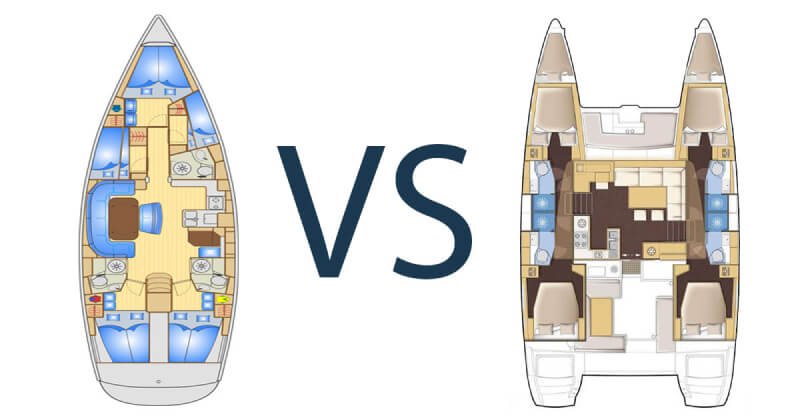
When it comes to sailboats, there are two main types that dominate the sailing world: monohull and multihull. Each has its own distinct characteristics and advantages. Let’s take a closer look at these two types of sailboats.
Monohull Sailboats
Monohull sailboats, as the name suggests, have a single hull. They are the traditional choice for most sailors and offer several key benefits:
- Stability: Monohulls have a deep keel that provides excellent stability in rough seas.
- Performance: These sailboats cut through the water with ease, allowing for faster speeds and better upwind performance.
- Simplicity: With fewer moving parts, monohulls are generally easier to maintain and operate.
However, there are also a few drawbacks to consider:
- Limited interior space: The single hull design limits the amount of interior space available for living quarters or storage.
- Draft limitations: Monohulls tend to have deeper drafts, which can limit access to shallower anchorages or marinas.
- Heeling: When sailing on an angle, monohulls can tilt or heel over more compared to multihulls.
Multihull Sailboats
Multihull sailboats are designed with multiple hulls connected by a deck or platform. Common examples include catamarans and trimarans. Here are some notable features of multihulls:
- Ample space: The wider platform of multihulls allows for spacious interiors with separate cabins, living areas, and generous storage options.
- Shallow draft: Multihulls typically have shallower drafts than monohulls, enabling access to shallow anchorages and coastal areas.
- Stability: Due to their wide beam distribution and buoyancy from multiple hulls, multihulls offer excellent stability both at anchor and under sail.
However, there are a few trade-offs to consider:
- Cost: Multihulls tend to be more expensive than monohulls due to their larger size and additional construction materials.
- Docking limitations: The wider beam of multihulls can make docking in narrow slips or crowded marinas more challenging.
- Performance trade-offs: While multihulls excel in reaching and downwind sailing, they may not perform as well upwind compared to monohulls.
In summary, choosing between a monohull and multihull sailboat ultimately depends on your specific preferences, priorities, and intended use. Monohulls offer stability, simplicity, and better upwind performance but with limited interior space. Multihulls provide ample space, shallow draft capabilities, and excellent stability at the cost of higher prices and potential docking challenges. Consider your needs carefully before making a decision. Happy sailing!
Examining Popular Classes Types of Sailboats
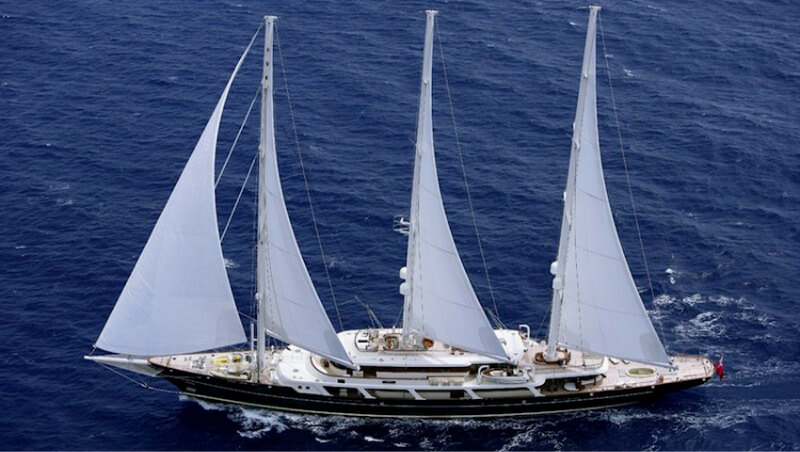
Sailboats come in a variety of shapes and sizes, each designed for specific purposes and preferences. Whether you’re a seasoned sailor or just starting out, it’s important to understand the different classes of sailboats available. In this section, we’ll take a closer look at some popular classes of sailboats and what sets them apart.
1. Dinghies
Dinghies are small, lightweight sailboats that are often used for racing or recreational sailing. They typically have a single mast and can be sailed by one or two people. Dinghies are known for their agility and responsiveness on the water, making them perfect for learning basic sailing skills.
2. Sloops
Sloops are one of the most common types of sailboats found today. They feature a single mast with two sails: a mainsail and a headsail (usually called a jib). Sloops are versatile and can be easily handled by small crews or even solo sailors. Their design allows for efficient upwind sailing while still offering good downwind performance.
3. Catamarans
Catamarans are twin-hulled sailboats that offer stability, speed, and spaciousness. With two hulls connected by a deck, catamarans provide ample living space both above and below deck, making them popular choices for cruising enthusiasts. Their wide beam allows for comfortable sailing even in choppy waters.
4. Trimarans
Trimarans feature three hulls – one main hull with two smaller outrigger hulls on either side. This unique design offers exceptional speed and stability, making trimarans ideal for competitive racing or long-distance cruising adventures. The additional stability provided by the outriggers allows trimarans to handle rough seas with ease.
5. Yawls
Yawls have two masts – a taller mainmast located near the center of the boat and a smaller mizzen mast positioned aft. The mizzen mast helps with balance and maneuverability, making yawls suitable for offshore cruising. Yawls are often admired for their classic beauty and traditional sailing experience.
6. Ketches
Similar to yawls, ketches have two masts, but with the mainmast located forward of the rudderpost. This configuration provides better balance and allows for more sail combinations, making ketches versatile in various wind conditions. Ketches are favored by long-distance cruisers due to their stability and ease of handling.
7. Schooners
Schooners are characterized by their multiple masts, typically two or more, with fore-and-aft sails on each mast. With their impressive sail area, schooners can achieve impressive speeds while still maintaining good control. Traditionally used as working vessels or pirate ships, schooners now evoke a sense of nostalgia and elegance on the water.
Understanding these popular classes of sailboats will help you choose the right vessel for your sailing adventures. Whether you’re seeking speed, comfort, or a bit of both, there’s a sailboat class out there that suits your needs perfectly!
Choosing the Right Types of Sailboats for Your Needs
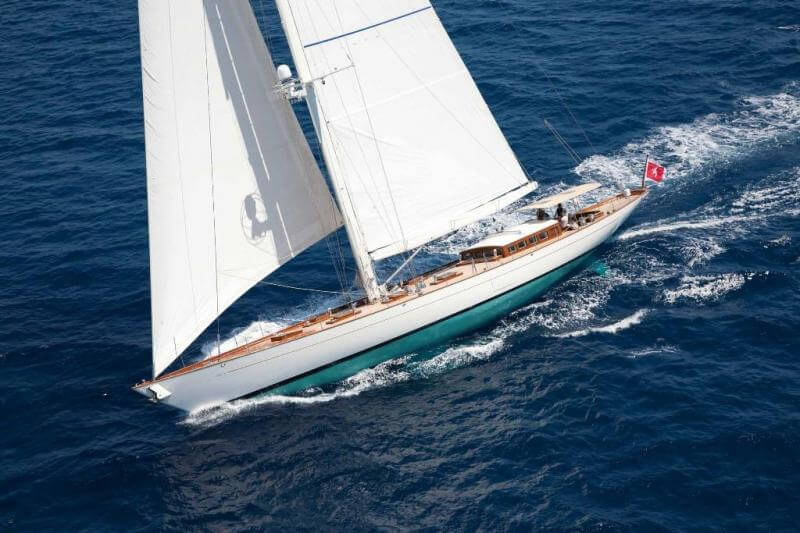
When it comes to choosing the right sailboat for your needs, there are several factors to consider. From the size and type of sailboat to your experience level and intended use, each aspect plays a crucial role in finding the perfect vessel. Here are some key points to help guide you in making an informed decision:
Size matters
The size of the sailboat is one of the first things to consider. Smaller boats, such as dinghies or daysailers, are great for beginners or those looking for a more casual sailing experience. Larger boats offer more space and comfort but require more skill and maintenance.
Type of sailboat
There are various types of sailboats available, each designed with specific purposes in mind. Some common types include cruising sailboats, racing boats, catamarans, trimarans, and keelboats. Determine what activities you plan on doing with your boat to narrow down your options.
Your sailing experience
Consider your level of sailing expertise when selecting a sailboat. If you’re a beginner, opt for a boat that’s easy to handle and forgiving on mistakes. As you gain more experience and confidence, you can upgrade to a boat with higher performance capabilities.
Intended use
Think about how you plan on using your sailboat. Will it be primarily for day trips or weekend getaways? Do you have aspirations for long-distance cruising or competitive racing? Different boats excel in different areas, so choose one that aligns with your goals.
Budget considerations
Set a budget before embarking on your search for the perfect sailboat. Keep in mind that not only do you need to purchase the boat itself but also factor in ongoing costs like mooring fees, maintenance expenses, insurance premiums, fuel costs, and equipment upgrades.
Try before buying
Whenever possible, take the opportunity to test sailboats before making a final decision. This allows you to get a feel for their handling, comfort, and overall suitability for your needs.
Remember that choosing the right sailboat is a personal decision based on your unique preferences and circumstances. Take your time, do thorough research, and consult with experienced sailors or boat dealers if needed. Happy sailing!
Conclusion
Now that you’ve explored the different types of sailboats, it’s time to wrap up our discussion. In this article, we’ve covered a wide range of sailboat designs, each with its own unique characteristics and purposes.
Remember, the best way to determine which type of sailboat suits you is to consider your sailing goals, experience level, and intended use. Whether you’re a seasoned sailor or just starting out, there’s always something new to discover in the world of sailboats.
So, get out on the water, feel the wind in your sails, and embark on your own sailing adventures. Happy sailing!

